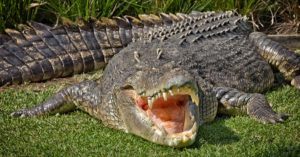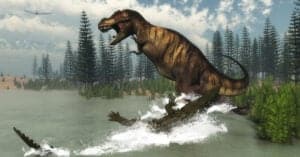The Largest Saltwater Crocodile in the World
@media (min-width: 481px) {
.mobile-top-content {
display: none;
}
}
#mobileTopContentCTACarouselControls { overflow: hidden; text-overflow: ellipsis; white-space: nowrap; }
.mobile-top-content .more { color: #fff; }
.mobile-top-content a { color: #fff; text-decoration: underline; }
.mobile-top-content a:hover { color: #fff; text-decoration: underline; }
@media (max-width: 480px) {
.mobile-top-content {
background-color: #06a10b;
color: #fff;
text-align: center;
/*height: 60px;
padding-top:5px;*/
font-size:80%;
/* display: block; */
margin: 0px -30px;
}
}
Key Points
- Crocodiles have been around for over 60 million years.
- Today, the saltwater crocodile is that largest crocodilian on the planet.
- The largest saltwater crocodile was found in the Philippines.
Saltwater crocodiles (Crocodylus porosus) are the largest living reptiles on Earth. They’re even bigger than the fearsome Nile crocodile and dwarf alligators, gharials, and caimans. But, just how big is the largest saltwater crocodile in the world? Over the years, many contenders have been reported, but only a few of them have been accurately measured. This species may not grow to the same size as its ancient ancestors (some of which grew to over 30 feet!), but it can still grow to gargantuan proportions.
Many people may mistakenly believe that alligators are larger than crocodiles, but this is not the case. Alligators generally grow to about 13-14 ft long, while crocodiles reach 17 ft and longer. Another distinguishing feature of these crocodilians is their snouts. Alligators have a broad snout while crocodiles have elongated, thin snouts. Both species can be quite threatening, however, crocodiles are more aggressive and are known to kill humans while alligators rarely ever do.
As apex predators, the largest saltwater crocodiles in the world have little to fear. But, even these fearsome, incredible creatures have fallen victim to poaching, capture, and habitat loss. That’s why, now more than ever, it’s important to understand the role crocodiles play in our ecosystems. Here, we’ll learn about a few of the largest saltwater crocodiles ever recorded and what you can do to ensure that these magnificent creatures are still around for the next generation.
Let’s get started!
The Scoop on Crocodiles
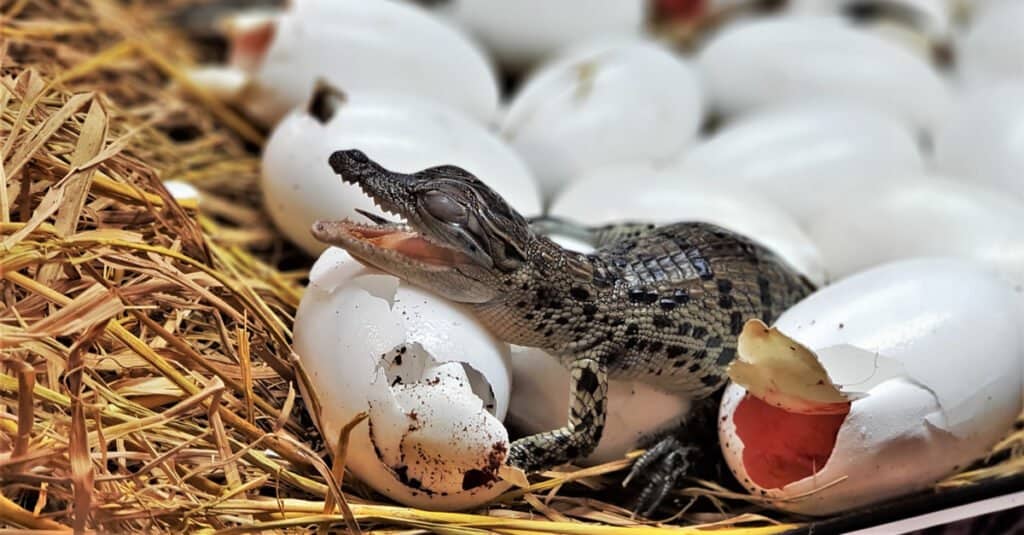
Arunee Rodloy/Shutterstock.com
Crocodiles have been around for over 60 million years; that’s a long time! They’re called saltwater crocodiles because they can survive in salty water. Because of this, they’re commonly known as ‘salties’ in Australia. Salties start life as eggs carefully guarded by their mother. When they hatch, they’re so small that they feast mainly on small fish, insects, and amphibians. As they grow, the baby crocodiles learn to consume bigger and bigger prey. The largest saltwater crocodile adults can eat prey as big as pigs, water buffalo, and kangaroos.
If you’ve never seen a crocodile, perhaps the best way to describe them is as the rulers of the river. They’re big, scaly, and impressive. All saltwater crocodiles are dull green on the sides and back and pale tan on the belly. They have long snouts filled with conical teeth. Interestingly, their teeth aren’t meant for shearing, like a lion’s. Instead, they’re used to clamp down on prey (crocodiles have one of the strongest bite forces on Earth) during ambush and consumption.
Where are the Largest Crocodiles on Earth?
You may be wondering, just where do the largest saltwater crocodiles on Earth live? They’re actually native to Indonesia, Southeast Asia, eastern India, and the northern coast of Australia. Saltwater crocodiles inhabit mangrove swamps, marshes, rivers, lakes, ponds, and even coastal ocean waters. Their favorite haunts include murky waters where they can remain concealed below the water, waiting for unsuspecting prey. Saltwater crocodiles can lie in wait like this for up to seven hours!
What are the Largest Crocodiles on Earth?
There are many folktales about monstrous crocs, but only a few verified giants. Saltwater crocodiles were hunted mercilessly in the decades before they became a protected species, so modern giants are rare. Here, we’ll take a look at three of the largest saltwater crocodiles ever reliably measured. Number one on our list was gargantuan!
3. Crocodile in the Wild

Pius Rino Pungkiawan/Shutterstock.com
In 2017, a passerby spotted a deceased saltwater crocodile floating in a river in northern Queensland, Australia. Saltwater crocodiles are a protected species, meaning it is illegal to kill them. Unfortunately, though, when crocodile experts inspected the body, they found that the mystery croc had been shot to death with a large caliber rifle.
Only, this was no normal crocodile. When measured, the salty in question turned out to be one of the largest saltwater crocodiles in the world. The nameless behemoth measured just over 17 feet. Had he been allowed to live and continue growing, he just might have become the largest saltwater crocodile on Earth. Still, experts agree that this unfortunate crocodile was one of the largest wild salties seen in more than three decades.
2. Cassius
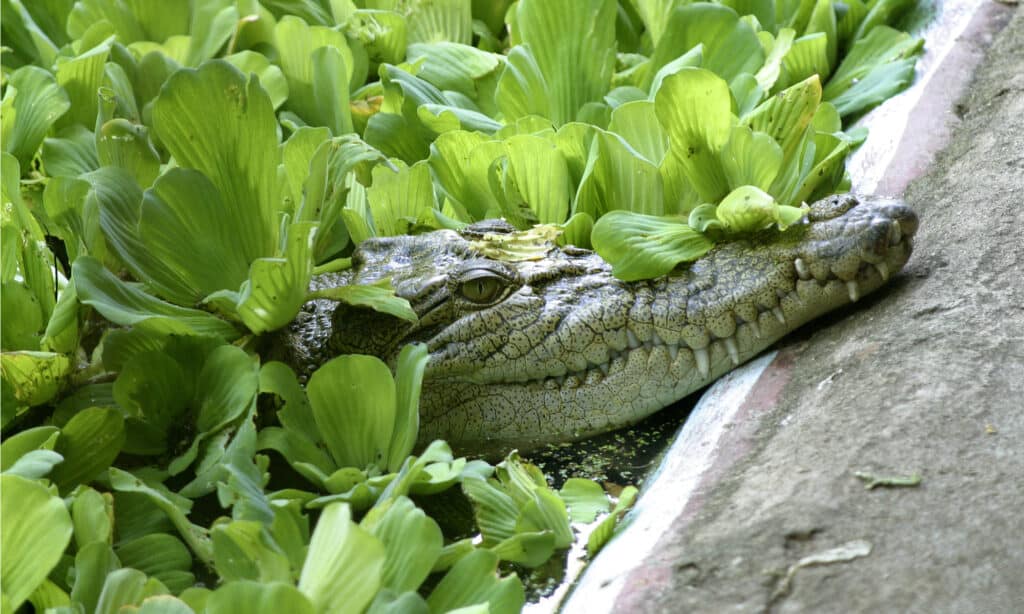
Bob Stilwell/Shutterstock.com
The title of the largest living saltwater crocodile on Earth belongs to a croc named Cassius. Cassius currently lives in a private marine park called Marineland Melanesia, off the coast of Australia. But, Cassius didn’t always live behind barbed wire—he started his life out as a wild salty. In 1984, a man named George Craig captured Cassius and placed him in his new, tiny home for the enjoyment of paying customers.
Today, Cassius measures 18 feet long. He’s the largest saltwater crocodile on Earth—that’s alive. There’s still one more crocodile who makes even Cassius look small, let’s check him out!
1. Lolong
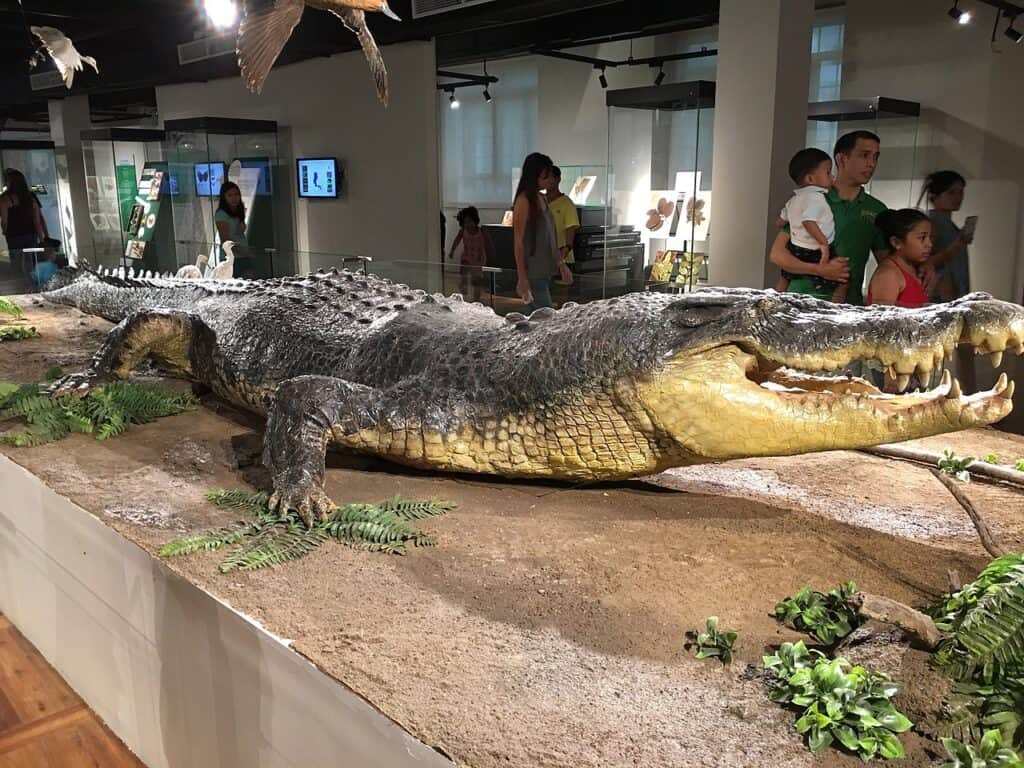
Julan Shirwod Nueva / Creative Commons – License
The largest saltwater crocodile ever reliably measured was Lolong, the crocodile from an unknown pond in the Philippines. Lolong lived in the wild until 2011 when he was summarily blamed for the deaths of several water buffaloes, and the disappearances of two people. In 2011, professional crocodile hunters captured Lolong and discovered that they had just caught the world’s largest saltwater crocodile.
Lolong measured 20 feet and 3 inches long and nearly 2,400 pounds. He was quickly transferred to Bunawan Ecopark in the Philippines, where spectators could purchase tickets to behold his massive bulk.
Unfortunately for this legendary salty, this meant that the water in his enclosure was frequently drained so that tourists could see him. At the time, Lolong would have been at least 70 years old, meaning that he needed the water to keep his organs from crushing themselves due to his tremendous weight. This practice, coupled with poor conditions, led to Lolong’s death less than two years after his capture.
Conservation: The Largest Saltwater Crocodiles in the World
After decades of legal killing of saltwater crocs, few giants remain. Today, sightings of crocodiles over five meters long are exceptionally rare. Unfortunately for the largest saltwater crocodiles on Earth, they’re not always treated with the compassion and respect they deserve. In order to preserve these magnificent creatures for the next generation, it’s important to learn about them. And, whenever possible, leave them in their wild homes to live as nature intended.
Summary: Largest Saltwater Crocodiles
| Crocodile | Size |
|---|---|
| Lolong | 20 ft 3 in |
| Cassius | 18 ft |
| Wild croc | 17 ft |
Up Next…
Curious to learn more about crododilians and their great sizes? Check out the following:
- The Top 9 Largest Alligators Ever – Can you guess where the largest alligator ever was found?
- Discover The Largest Nile Crocodile Ever – Nile crocodiles are some of the largest, scariest reptiles to walk the earth.
- Discover the Largest Crocodile Attack in Human History (500+ Died) – Crocodiles are more aggressive towards humans and do attack.
More from A-Z Animals
.more-snake-card-image { max-height:140px !important; }
@media (min-width: 481px) {
.mobile-top-content {
display: none;
}
}
#mobileTopContentCTACarouselControls { overflow: hidden; text-overflow: ellipsis; white-space: nowrap; }
.mobile-top-content .more { color: #fff; }
.mobile-top-content a { color: #fff; text-decoration: underline; }
.mobile-top-content a:hover { color: #fff; text-decoration: underline; }
@media (max-width: 480px) {
.mobile-top-content {
background-color: #06a10b;
color: #fff;
text-align: center;
/*height: 60px;
padding-top:5px;*/
font-size:80%;
/* display: block; */
margin: 0px -30px;
}
}
Key Points
- Crocodiles have been around for over 60 million years.
- Today, the saltwater crocodile is that largest crocodilian on the planet.
- The largest saltwater crocodile was found in the Philippines.
Saltwater crocodiles (Crocodylus porosus) are the largest living reptiles on Earth. They’re even bigger than the fearsome Nile crocodile and dwarf alligators, gharials, and caimans. But, just how big is the largest saltwater crocodile in the world? Over the years, many contenders have been reported, but only a few of them have been accurately measured. This species may not grow to the same size as its ancient ancestors (some of which grew to over 30 feet!), but it can still grow to gargantuan proportions.
Many people may mistakenly believe that alligators are larger than crocodiles, but this is not the case. Alligators generally grow to about 13-14 ft long, while crocodiles reach 17 ft and longer. Another distinguishing feature of these crocodilians is their snouts. Alligators have a broad snout while crocodiles have elongated, thin snouts. Both species can be quite threatening, however, crocodiles are more aggressive and are known to kill humans while alligators rarely ever do.
As apex predators, the largest saltwater crocodiles in the world have little to fear. But, even these fearsome, incredible creatures have fallen victim to poaching, capture, and habitat loss. That’s why, now more than ever, it’s important to understand the role crocodiles play in our ecosystems. Here, we’ll learn about a few of the largest saltwater crocodiles ever recorded and what you can do to ensure that these magnificent creatures are still around for the next generation.
Let’s get started!
The Scoop on Crocodiles

Arunee Rodloy/Shutterstock.com
Crocodiles have been around for over 60 million years; that’s a long time! They’re called saltwater crocodiles because they can survive in salty water. Because of this, they’re commonly known as ‘salties’ in Australia. Salties start life as eggs carefully guarded by their mother. When they hatch, they’re so small that they feast mainly on small fish, insects, and amphibians. As they grow, the baby crocodiles learn to consume bigger and bigger prey. The largest saltwater crocodile adults can eat prey as big as pigs, water buffalo, and kangaroos.
If you’ve never seen a crocodile, perhaps the best way to describe them is as the rulers of the river. They’re big, scaly, and impressive. All saltwater crocodiles are dull green on the sides and back and pale tan on the belly. They have long snouts filled with conical teeth. Interestingly, their teeth aren’t meant for shearing, like a lion’s. Instead, they’re used to clamp down on prey (crocodiles have one of the strongest bite forces on Earth) during ambush and consumption.
Where are the Largest Crocodiles on Earth?
You may be wondering, just where do the largest saltwater crocodiles on Earth live? They’re actually native to Indonesia, Southeast Asia, eastern India, and the northern coast of Australia. Saltwater crocodiles inhabit mangrove swamps, marshes, rivers, lakes, ponds, and even coastal ocean waters. Their favorite haunts include murky waters where they can remain concealed below the water, waiting for unsuspecting prey. Saltwater crocodiles can lie in wait like this for up to seven hours!
What are the Largest Crocodiles on Earth?
There are many folktales about monstrous crocs, but only a few verified giants. Saltwater crocodiles were hunted mercilessly in the decades before they became a protected species, so modern giants are rare. Here, we’ll take a look at three of the largest saltwater crocodiles ever reliably measured. Number one on our list was gargantuan!
3. Crocodile in the Wild

Pius Rino Pungkiawan/Shutterstock.com
In 2017, a passerby spotted a deceased saltwater crocodile floating in a river in northern Queensland, Australia. Saltwater crocodiles are a protected species, meaning it is illegal to kill them. Unfortunately, though, when crocodile experts inspected the body, they found that the mystery croc had been shot to death with a large caliber rifle.
Only, this was no normal crocodile. When measured, the salty in question turned out to be one of the largest saltwater crocodiles in the world. The nameless behemoth measured just over 17 feet. Had he been allowed to live and continue growing, he just might have become the largest saltwater crocodile on Earth. Still, experts agree that this unfortunate crocodile was one of the largest wild salties seen in more than three decades.
2. Cassius

Bob Stilwell/Shutterstock.com
The title of the largest living saltwater crocodile on Earth belongs to a croc named Cassius. Cassius currently lives in a private marine park called Marineland Melanesia, off the coast of Australia. But, Cassius didn’t always live behind barbed wire—he started his life out as a wild salty. In 1984, a man named George Craig captured Cassius and placed him in his new, tiny home for the enjoyment of paying customers.
Today, Cassius measures 18 feet long. He’s the largest saltwater crocodile on Earth—that’s alive. There’s still one more crocodile who makes even Cassius look small, let’s check him out!
1. Lolong

Julan Shirwod Nueva / Creative Commons – License
The largest saltwater crocodile ever reliably measured was Lolong, the crocodile from an unknown pond in the Philippines. Lolong lived in the wild until 2011 when he was summarily blamed for the deaths of several water buffaloes, and the disappearances of two people. In 2011, professional crocodile hunters captured Lolong and discovered that they had just caught the world’s largest saltwater crocodile.
Lolong measured 20 feet and 3 inches long and nearly 2,400 pounds. He was quickly transferred to Bunawan Ecopark in the Philippines, where spectators could purchase tickets to behold his massive bulk.
Unfortunately for this legendary salty, this meant that the water in his enclosure was frequently drained so that tourists could see him. At the time, Lolong would have been at least 70 years old, meaning that he needed the water to keep his organs from crushing themselves due to his tremendous weight. This practice, coupled with poor conditions, led to Lolong’s death less than two years after his capture.
Conservation: The Largest Saltwater Crocodiles in the World
After decades of legal killing of saltwater crocs, few giants remain. Today, sightings of crocodiles over five meters long are exceptionally rare. Unfortunately for the largest saltwater crocodiles on Earth, they’re not always treated with the compassion and respect they deserve. In order to preserve these magnificent creatures for the next generation, it’s important to learn about them. And, whenever possible, leave them in their wild homes to live as nature intended.
Summary: Largest Saltwater Crocodiles
| Crocodile | Size |
|---|---|
| Lolong | 20 ft 3 in |
| Cassius | 18 ft |
| Wild croc | 17 ft |
Up Next…
Curious to learn more about crododilians and their great sizes? Check out the following:
- The Top 9 Largest Alligators Ever – Can you guess where the largest alligator ever was found?
- Discover The Largest Nile Crocodile Ever – Nile crocodiles are some of the largest, scariest reptiles to walk the earth.
- Discover the Largest Crocodile Attack in Human History (500+ Died) – Crocodiles are more aggressive towards humans and do attack.


